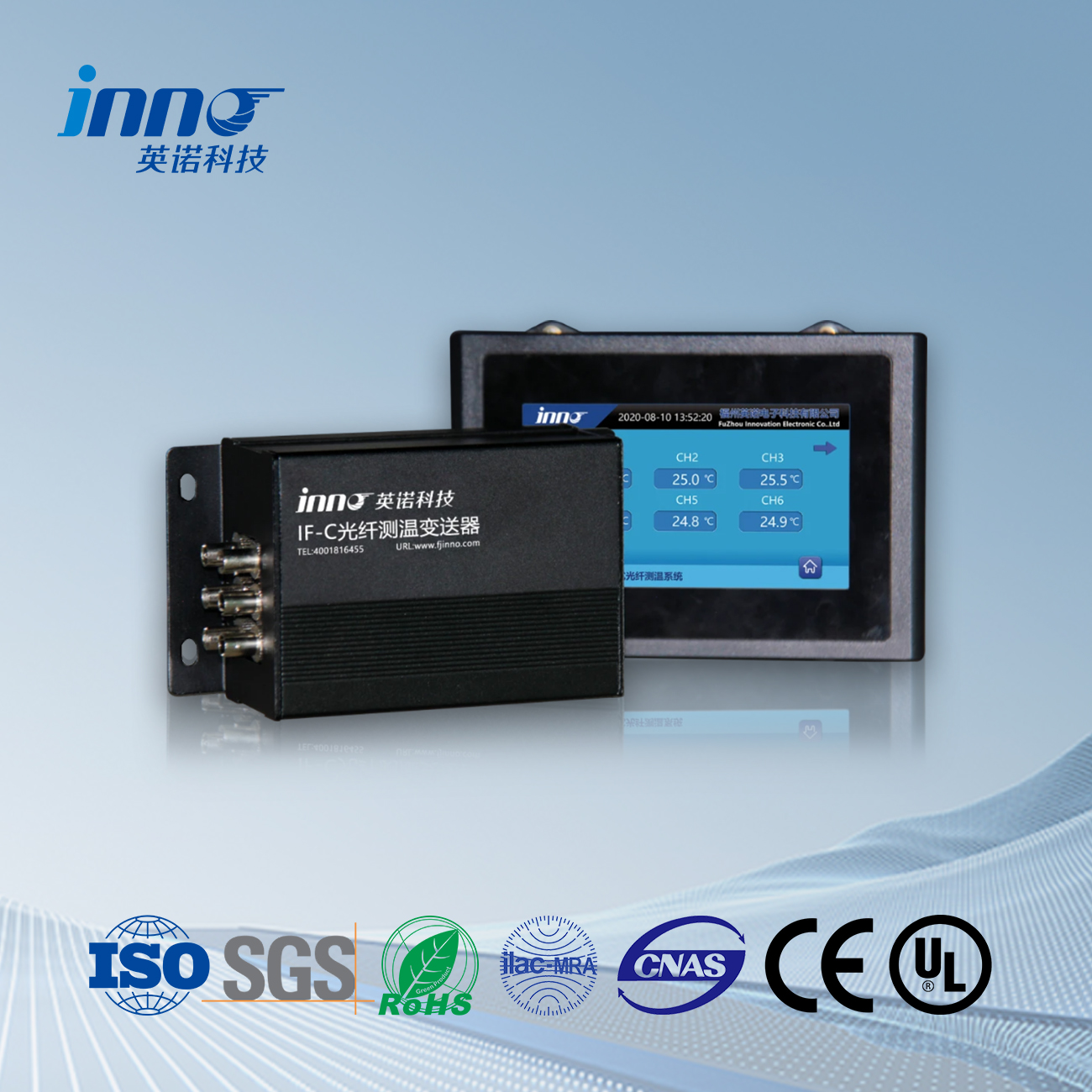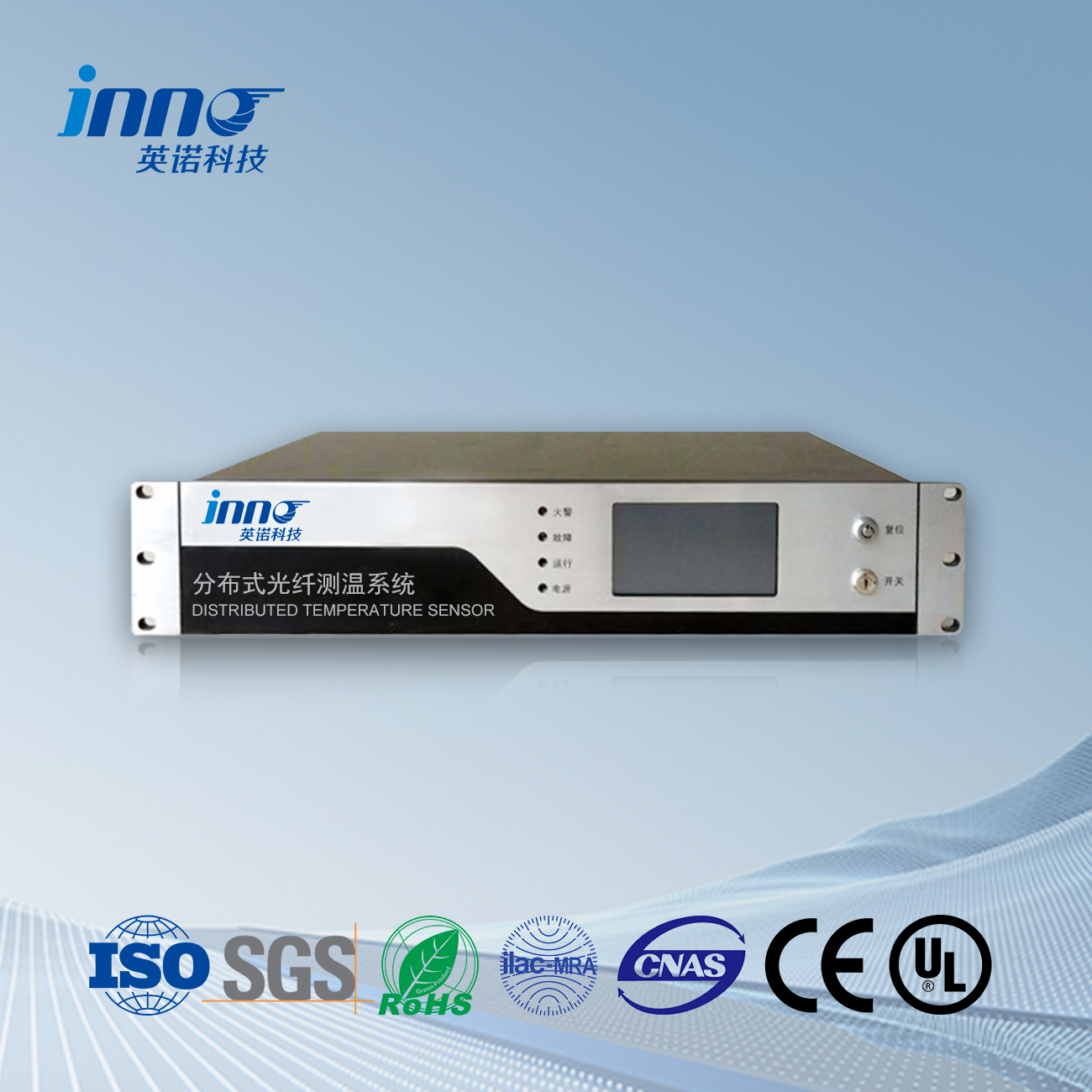Introduction to Concrete Fiber Optic Monitoring
The integration of fiber optic technology with concrete structures represents one of the most significant advancements in modern infrastructure monitoring. This innovative approach embeds optical fibers directly within concrete elements during construction, creating “smart concrete” capable of providing real-time data about structural health, temperature variations, strain distribution, and early warning signals of potential failures. Among the various fiber optic sensing technologies available today, FJINNO’s fluorescent fiber optic sensors stand out for their exceptional accuracy, durability, and comprehensive monitoring capabilities in concrete applications.

Key Benefits of Concrete Fiber Optic Monitoring
- Structural Health Monitoring: Real-time assessment of concrete integrity throughout the structure’s lifecycle
- Early Damage Detection: Identification of cracks, deformations, and structural weaknesses before they become visible
- Curing Process Optimization: Precise temperature and strain monitoring during concrete curing
- Seismic Performance Evaluation: Detailed response data during and after seismic events
- Long-term Durability Assessment: Continuous monitoring of structural performance over decades
- Enhanced Safety: Predictive maintenance capabilities that significantly improve safety margins
Understanding Fiber Optic Sensing in Concrete Structures
Fiber optic sensing in concrete operates on fundamental principles of light transmission and reflection. Unlike traditional electrical sensors, fiber optic systems are immune to electromagnetic interference, resistant to harsh environments, and capable of distributed sensing along the entire fiber length. This makes them ideally suited for the challenging conditions found in concrete structures, from massive dams and bridges to high-rise buildings and tunnels.
FJINNO’s Fluorescent Fiber Optic Technology
FJINNO has pioneered the application of fluorescent fiber optic technology for concrete monitoring. This advanced approach offers significant advantages over conventional sensing methods:
- Temperature Measurement Precision: Industry-leading accuracy of ±0.5°C across wide temperature ranges
- Point-based or Distributed Sensing: Options for both discrete point measurements and continuous monitoring along fiber lengths
- Long-Term Stability: Minimal signal drift over decades, ensuring reliable data throughout structure lifespan
- Multiplexing Capability: Single monitoring unit can interrogate up to 64 separate sensing points
- Chemical Resistance: Specially formulated coatings resist the high alkalinity of concrete environments
- Strain Measurement: Precise detection of microstrain levels for early warning of structural issues
Working Principle of Fluorescent Fiber Optic Sensors
FJINNO’s fluorescent technology operates on a fundamentally different principle than traditional fiber optic sensors:
- The sensor tip contains specialized fluorescent materials that respond to temperature and/or strain changes
- Short pulses of excitation light are sent through the optical fiber to the embedded sensor
- The fluorescent material absorbs this light and re-emits it at a longer wavelength
- The decay time of this fluorescence precisely correlates with temperature
- For strain measurements, specialized sensors monitor changes in light intensity or wavelength shift
- The monitoring unit analyzes these optical signals to determine exact temperature and strain values
| Monitoring Parameter | FJINNO Fluorescent Technology | Traditional Electrical Sensors | Conventional Браг решетка со влакна |
|---|---|---|---|
| Temperature Accuracy | ±0.5°C | ±1-2°C | ±1°C |
| EMI Immunity | Complete | None | Complete |
| Long-term Stability | Excellent (25+ години) | Poor to Moderate | Good |
| Alkalinity Resistance | High (specialized coatings) | Low to Moderate | Moderate |
| Multiplexing Capability | Up to 64 points per channel | Individual wiring required | 10-20 sensors per fiber |
| Calibration Requirements | 5-7 години | 1-2 години | 2-3 години |
Critical Applications in Concrete Infrastructure
Fjinno concrete fiber optic monitoring systems have been successfully deployed in numerous high-value infrastructure projects. The technology provides critical data throughout the entire lifecycle of concrete structures, from initial curing to long-term monitoring:
1. Concrete Curing Monitoring
The curing phase is critical to concrete strength development and long-term durability. FJINNO’s fiber optic sensors provide:
- Hydration Heat Monitoring: Precise tracking of temperature evolution during cement hydration
- Temperature Differential Detection: Early warning of excessive temperature gradients that could lead to thermal cracking
- Curing Rate Optimization: Data-driven adjustment of curing conditions to achieve optimal strength development
- Quality Assurance: Verification that curing follows design specifications
2. Structural Health Monitoring in Critical Infrastructure
For bridges, dams, tunnels, and high-rise buildings, ongoing structural health monitoring is essential for safety and maintenance planning:
- Load Distribution Analysis: Real-time monitoring of how structural loads are distributed through concrete elements
- Deformation Detection: Early identification of unexpected structural movements or deformations
- Crack Formation Monitoring: Detection of microcracks before they become visible
- Post-Event Assessment: Rapid evaluation of structural integrity after earthquakes, floods, or other events
3. Geotechnical Applications
Fiber optic monitoring extends to the geotechnical aspects of concrete structures:
- Foundation Monitoring: Assessment of settlement, lateral movements, and load distribution
- Retaining Wall Stability: Continuous monitoring of earth pressure and structural response
- Tunnel Deformation: Precise measurement of convergence and lining stress in concrete tunnel segments
- Dam Safety Monitoring: Comprehensive assessment of structural behavior and seepage patterns
FJINNO ConcreteSense™ System Features
FJINNO’s flagship concrete monitoring solution offers comprehensive capabilities for infrastructure projects:
- Multi-Parameter Sensing: Simultaneous monitoring of temperature, strain, displacement, and vibration
- Ruggedized Sensors: Special designs for surviving the concrete pouring and compaction process
- Easy Installation: Mounting systems that securely attach to reinforcement before concrete placement
- Central Monitoring Unit: Powerful data acquisition system with advanced analytics capabilities
- Cloud Integration: Secure data storage and remote access from anywhere in the world
- Automated Alerts: Immediate notification when measurements exceed predefined thresholds
- Visualization Tools: Intuitive 3D visualization of sensor data mapped to structural elements
Студии на случај: Concrete Fiber Optic Monitoring in Action
Case Study 1: Major Dam Rehabilitation Project
Challenge: A 50-year-old concrete gravity dam was experiencing concerning temperature variations and potential internal stress issues. Engineers needed to understand the structural behavior during rehabilitation work and long-term performance.
Solution: FJINNO installed 128 fluorescent fiber optic sensors throughout the dam structure, focusing on areas of concern identified in preliminary assessments. The comprehensive систем за следење tracked temperature distributions and strain patterns before, during, and after rehabilitation work.
Results:
- Identification of previously unknown thermal gradients causing cyclical stress in critical sections
- Real-time verification that rehabilitation measures were effectively addressing structural issues
- Early detection of unexpected strain concentrations, enabling targeted modifications to the repair approach
- Establishment of a baseline систем за следење for long-term dam safety assessment
- Estimated 30% cost savings by optimizing rehabilitation efforts based on precise structural data
Case Study 2: High-Rise Building Foundation Monitoring
Challenge: A 60-story skyscraper was being constructed in challenging soil conditions. Engineers needed to monitor foundation behavior during construction and early building life to verify design assumptions.
Solution: FJINNO’s concrete embedded fiber optic sensors were installed throughout the massive mat foundation and critical structural elements. The system provided continuous data on temperature development during curing and subsequent structural loading.
Results:
- Optimization of concrete curing protocols based on real-time temperature data, reducing curing time by 15%
- Detection of unexpected foundation behavior during early construction, enabling proactive design adjustments
- Verification that differential settlement remained within acceptable limits as construction progressed
- Creation of a detailed structural baseline for future building health monitoring
- Integration with building management systems for continuous structural health assessment
“FJINNO’s fiber optic monitoring system provided unprecedented insight into our concrete structure’s behavior. The data quality and system reliability have far exceeded our expectations, giving us confidence in both our construction process and long-term structural performance.
— Chief Structural Engineer, International Engineering Consultancy
Implementation Methodology
Successful concrete fiber optic monitoring implementation requires careful planning and execution. FJINNO provides comprehensive support throughout this process:
- Assessment and Planning: Detailed evaluation of monitoring requirements and strategic sensor placement design
- Sensor Preparation: Custom configuration of sensing elements for the specific project requirements
- Installation Support: Technical guidance for proper sensor positioning and protection during concrete placement
- System Integration: Connection of optical components and commissioning of monitoring equipment
- Baseline Establishment: Initial data collection to establish reference conditions
- Ongoing Monitoring: Continuous or periodic data acquisition according to project requirements
- Data Analysis: Expert interpretation of monitoring results and correlation with structural behavior
- Reporting and Recommendations: Comprehensive documentation and engineering guidance based on monitoring findings
Future Trends in Concrete Fiber Optic Monitoring
The field of concrete fiber optic monitoring continues to evolve rapidly. FJINNO is at the forefront of several key advancements:
- AI-Enhanced Data Analytics: Machine learning algorithms that identify subtle patterns indicating developing structural issues
- Self-Healing Concrete Integration: Monitoring systems that trigger self-healing mechanisms in specialized concrete formulations
- Expanded Distributed Sensing: Higher-resolution distributed temperature and strain sensing along entire fiber lengths
- Wireless Data Transmission: Reduced dependence on cabled connections for data collection
- Digital Twin Integration: Seamless incorporation of monitoring data into comprehensive structural digital twins
- Life-Cycle Optimization: Predictive models that maximize infrastructure lifespan based on continuous monitoring data
Frequently Asked Questions (Најчесто поставувани прашања)
How long do FJINNO’s fiber optic sensors last when embedded in concrete?
FJINNO’s fiber optic sensors are designed and tested for a service life exceeding 25 years when properly embedded in concrete structures. The specialized coatings and packaging materials are specifically formulated to withstand the harsh alkaline environment of concrete and remain stable throughout the structure’s lifetime.
Can fiber optic sensors be installed in existing concrete structures?
While optimal installation occurs during initial construction, FJINNO offers specialized solutions for retrofitting existing structures. These include surface-mounted sensors for strain and temperature monitoring, installation in drilled holes with specialized grouts, and monitoring systems for structural reinforcement projects. The specific approach depends on the monitoring objectives and structural access conditions.
How do fiber optic sensors survive the concrete pouring and vibration process?
FJINNO’s concrete sensors feature ruggedized designs specifically engineered to withstand the harsh conditions of concrete placement. These include protective housings, reinforced cable entries, and secure mounting systems that attach to rebar cages or formwork. Additionally, FJINNO provides detailed installation guidelines and on-site support for critical projects to ensure sensor survival during construction.
What is the typical accuracy of temperature measurements in concrete applications?
Fjinno fluorescent fiber optic temperature sensors provide industry-leading accuracy of ±0.5°C across the full range of concrete temperatures, from curing peaks to operational conditions. This high precision enables detection of subtle temperature variations that might indicate developing issues within the structure.
Can FJINNO’s monitoring systems integrate with existing structural health monitoring platforms?
Yes, FJINNO’s systems are designed with comprehensive integration capabilities. They support standard industrial protocols and data formats, allowing seamless connection with most existing structural monitoring platforms, SCADA systems, and building management systems. FJINNO also provides custom integration services for specialized applications and proprietary monitoring frameworks.
What is the typical return on investment for concrete fiber optic monitoring?
The ROI for concrete fiber optic monitoring varies by application but is typically realized through several value streams: construction optimization (5-15% savings on concrete curing time), early problem detection (avoiding costly remediation), extended asset lifespan (typically 15-30% through optimized maintenance), and reduced inspection costs. For critical infrastructure, preventing even a single structural failure or extending service life by a few years can provide returns many times the monitoring investment.
Transform Your Concrete Infrastructure with FJINNO Monitoring Solutions
Contact FJINNO today to discover how our advanced fluorescent fiber optic sensing technology can enhance the safety, reliability, and longevity of your concrete structures.
Сензор за температура со оптички влакна, Интелигентен систем за следење, Дистрибуиран производител на оптички влакна во Кина
 |
 |
 |
 INNO температурни сензори со оптички влакна ,системи за следење на температурата.
INNO температурни сензори со оптички влакна ,системи за следење на температурата.
